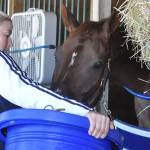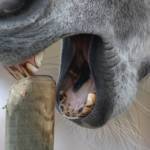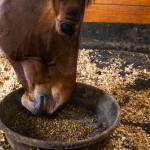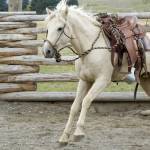New Muscle Disease Identified in Quarter Horses
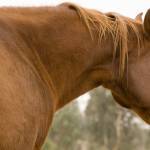
Scientists have unearthed a new muscle disease in Quarter Horses and related breeds known as immune-mediated myositis or IMM.
“IMM is an important yet relatively rare cause of muscle atrophy in Quarter Horses. The disease presents with malaise, muscle weakness, and atrophy,” explained Laura Petroski, B.V.M.S., a veterinarian for Kentucky Equine Research.
On microscopic examination, muscle biopsies collected from affected horses show a preponderance of inflammatory cells, particularly lymphocytes, which surround blood vessels and are found within muscle tissues and inside individual muscle cells.
The underlying cause for IMM remains unclear. According to researchers, which included renowned muscle researcher and longtime Kentucky Equine Research collaborator Stephanie Valberg, D.V.M., Ph.D., a combination of environmental stimuli and genetic factors are believed to be involved.
“The precise environmental trigger for IMM is not clear, but 39% of horses with IMM are reported to have a recent history of infection, particularly with Streptococci spp., or vaccination with influenza, herpes virus-1, or Streptococcus equi subsp. equi three to four weeks prior to onset,” wrote Valberg and colleagues.
To learn more about the genetic aspects of this disease in Quarter Horses, the research team collected DNA samples from 36 horses with IMM, 54 Quarter Horses without IMM, and an additional 175 horses from 21 other breeds. From their analyses, the researchers found a mutation in the MYH1 gene that encodes a myosin protein and plays an integral role in muscle contraction. That mutation ultimately affected 14 different amino acids in the myosin protein.
The researchers concluded that the MYH1 mutation “is highly associated with susceptibility to the IMM phenotype in breeds related to the Quarter Horse. This is the first report of a mutation in MYH1 and the first link between a skeletal muscle myosin mutation and autoimmune disease.”
Other important tidbits regarding IMM include:
- The majority of horses affected by IMM are Quarter Horses and related breeds;
- Certain stallions appear to be overrepresented, which supports a genetic basis for the condition;
- IMM primarily affects horses either less than 8 years old or more than 17 years old;
- Clinical signs of IMM often improve following treatment with corticosteroids, and full muscle mass is typically regained in 1 to 10 weeks; and
- Recurrence of muscle-wasting due to IMM can occur.
“While we cannot protect horses against existing genetic anomalies, offering products with natural anti-inflammatory ingredients such as the water-soluble vitamin E formulation Nano•E and the omega-3 fatty acids found in EO•3 may help horses affected with IMM or other immune-mediated disorders,” advised Petroski. “Always seek the care of your veterinarian with any health concerns regarding your horses, and consider a nutrition consultation to ensure adequate nutrients and energy are being provided to support muscle recovery in affected animals.”
*Finno, C.J., G. Gianino, S. Perumbakkam, et al. 2018. A missense mutation in MYH1 is associated with susceptibility to immune-mediated myositis in Quarter Horses. Skeletal Muscle 8(1):7.


